
salmonberry, Rubus spectabilis, blossom



Nearly lost: Re-introducing images of Vancouver’s native fruit trees
host
City of Vancouver Public Art Program
initial posters in the ongoing ‘Nearly Lost’ project
4 different posters installed in 20 bus shelters with the poster dimension 47.25 inches x 68.25 inches.
installation
October 10 to November 7, 2016 (with locations attached)
authorship
castle grünenfelder ingram (Julian Castle, Alex Grünenfelder, and Gordon Brent Brochu-Ingram with this project involving conceptualization by all three artists, research, photographing, and initial design conceptualization by Grünenfelder and Brochu-Ingram, text by Brochu-Ingram, and final designs and electronic conveyance by Grünenfelder)

text from project proposal
Nearly lost: Re-introducing images of Vancouver’s native fruit trees We propose large 2D imagery especially at bus stops, with video loop installations also possible for the video screens, of fruit and blossoms of several of the native fruit trees that have existed and continue to survive in the City of Vancouver — and that are of continued interest for First Native use, stewardship, and cultivation. Low resolution photographs would be enlarged, slightly saturated, and ‘montaged’ with educational text in English, Halkomelem (Musqueam and Tsleil-Waututh), Sḵwx̱wú7mesh snichim (Squamish) along with other widely spoken languages, and botanical Latin. For the 2015-2016, we would be able focus on making a number of montage posters celebrating two of the most common native fruit trees and more extensive Salish orchards, Pacific crabapple, Malus fusca, and chokecherry, Prunus virginiana ssp. demissa. Both of this crabapple species and this subspecies of chokecherry are limited to coastal ecosystems in BC, Alaska, and Washington State.
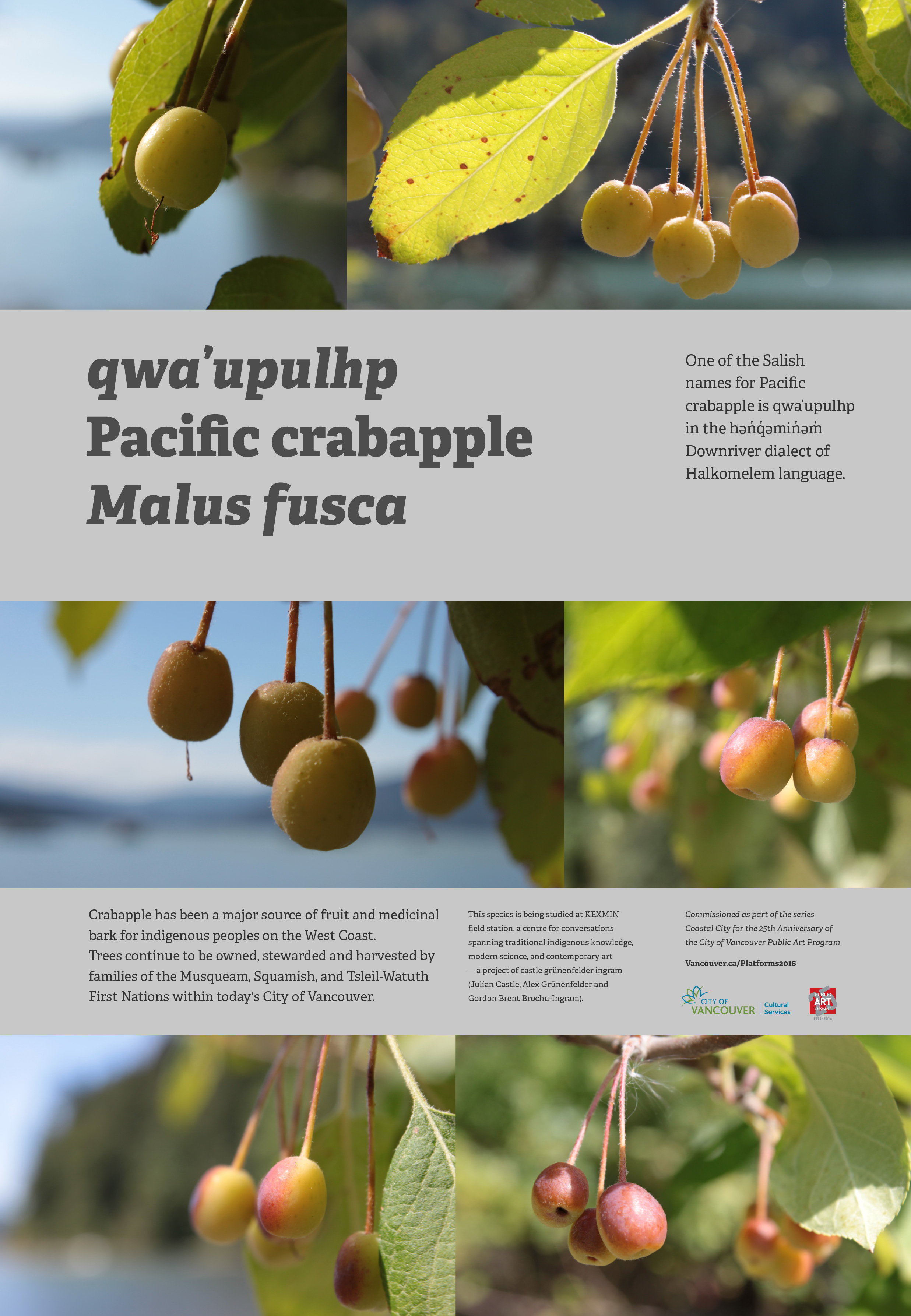
text on posters
four different posters with large type with,
1. lhexwlhéxw | chokecherry | Prunus virginiana
2. t’elemay (with two vertical accents over ‘m’ and ‘y’ and an acute accent over the ‘a’) | chokecherry | Prunus virginiana
3. ḵwu7úpay (with a vertical accent over the ‘y’) | Pacific crabapple | Malus fusca
4. qwa’upulhp | Pacific crabapple | Malus fusca
Along with the following headings is the following text for respective poster:
1. lhexwlhéxw | chokecherry | Prunus virginiana
One of the Salish names for chokecherry is lhexwlhéxw in the hən̓q̓əmin̓əm̓ Downriver dialect of Halkomelem language.
2. t’elemay (with two vertical accents over ‘m’ and ‘y’ and an acute accent over the ‘a’) | chokecherry | Prunus virginiana
One of the Salish names for chokecherry is t’elemay (with two vertical accents over ‘m’ and ‘y’ and an acute accent over the ‘a’) in the Sḵwx̱wú7mesh snichim language.
3. ḵwu7úpay (with a vertical accent over the ‘y’) | Pacific crabapple | Malus fusca One of the Salish names for Pacific crabapple is ḵwu7úpay (with a vertical accent over the ‘y’) in the Sḵwx̱wú7mesh snichim language.
4. qwa’upulhp | Pacific crabapple | Malus fusca One of the Salish names for Pacific crabapple is qwa’upulhp in the hən̓q̓əmin̓əm̓ Downriver and Island dialects of Halkomelem language.

For the two posters on chokecherry, there is the following text: Chokecherry has been a major source of fruit and medicinal bark for indigenous bark for indigenous peoples on the West Cost. Trees continue to be owned, stewarded and harvested by families of the Musqueam, Squamish, and Tsleil-Watuth First Nations within today’s City of Vancouver.
For the two posters on Pacific crabapple, there is the following text: Pacific crabapple has been a major source of fruit and medicinal bark for indigenous bark for indigenous peoples on the West Cost. Trees continue to be owned, stewarded and harvested by families of the Musqueam, Squamish, and Tsleil-Watuth First Nations within today’s City of Vancouver. For the two posters on chokecherry, there is the following text: Chokecherry has been a major source of fruit and medicinal bark for indigenous bark for indigenous peoples on the West Cost. Trees continue to be owned, stewarded and harvested by families of the Musqueam, Squamish, and Tsleil-Watuth First Nations within today’s City of Vancouver. For the two posters on Pacific crabapple, there is the following text: Pacific crabapple has been a major source of fruit and medicinal bark for indigenous bark for indigenous peoples on the West Cost. Trees continue to be owned, stewarded and harvested by families of the Musqueam, Squamish, and Tsleil-Watuth First Nations within today’s City of Vancouver.

All four posters have the following text: This species is being studied at KEXMIN field station, a centre for conversations spanning traditional indigenous knowledge, modern science, and contemporary art — a project of castle grünenfelder ingram (Julian Castle, Alex Grünenfelder and Gordon Brent Brochu-Ingram). The following text was provided by the City of Vancouver: Commissioned as part of the series Coastal City for the 25th Anniversary of the City of Vancouver Public Art Program Vancouver.ca/platform2016
media
Inkjet printer on paper photographing
The photographs in the attached images of the posters were photographed jointly by Alex Grünenfelder and Gordon Brent Brochu-Ingram. All of the photographs of the posters installed in the bus shelters were taken by by Alex Grünenfelder.
fabricators / suppliers
OUTFRONT MEDIA Decaux in cooperation with
the printer, LinxPrint, as service-providers to the City of Vancouver



drone video of Mount Maxwell Ecological Reserve, Salt Spring Island taken by Ben Taft on January 5, 2017 in cooperation with KEXMIN field station
Anna Lowenhaupt Tsing – A Feminist Approach to the Anthropocene: Earth Stalked by Man, November 10, 2015 Barnard Center for Research on Women, Barnard College, New York
Anna L. Tsing is a Professor of Anthropology at the University of California Santa Cruz, and the acclaimed author of several books including Friction: An Ethnography of Global Connection and In the Realm of the Diamond Queen.
 Pacific crabapple, qwa’upulhp (in the downriver dialect of Halkomelem), ḴÁ¸EW̱ (SENĆOŦEN), Malus fusca, north of the site of the village of Xwaaqw’um, Burgoyne Bay, Salt Spring Island 2016 August 11 & 12, photographs by Alex Grünenfelder & Gordon Brent Brochu-Ingram
Pacific crabapple, qwa’upulhp (in the downriver dialect of Halkomelem), ḴÁ¸EW̱ (SENĆOŦEN), Malus fusca, north of the site of the village of Xwaaqw’um, Burgoyne Bay, Salt Spring Island 2016 August 11 & 12, photographs by Alex Grünenfelder & Gordon Brent Brochu-Ingram







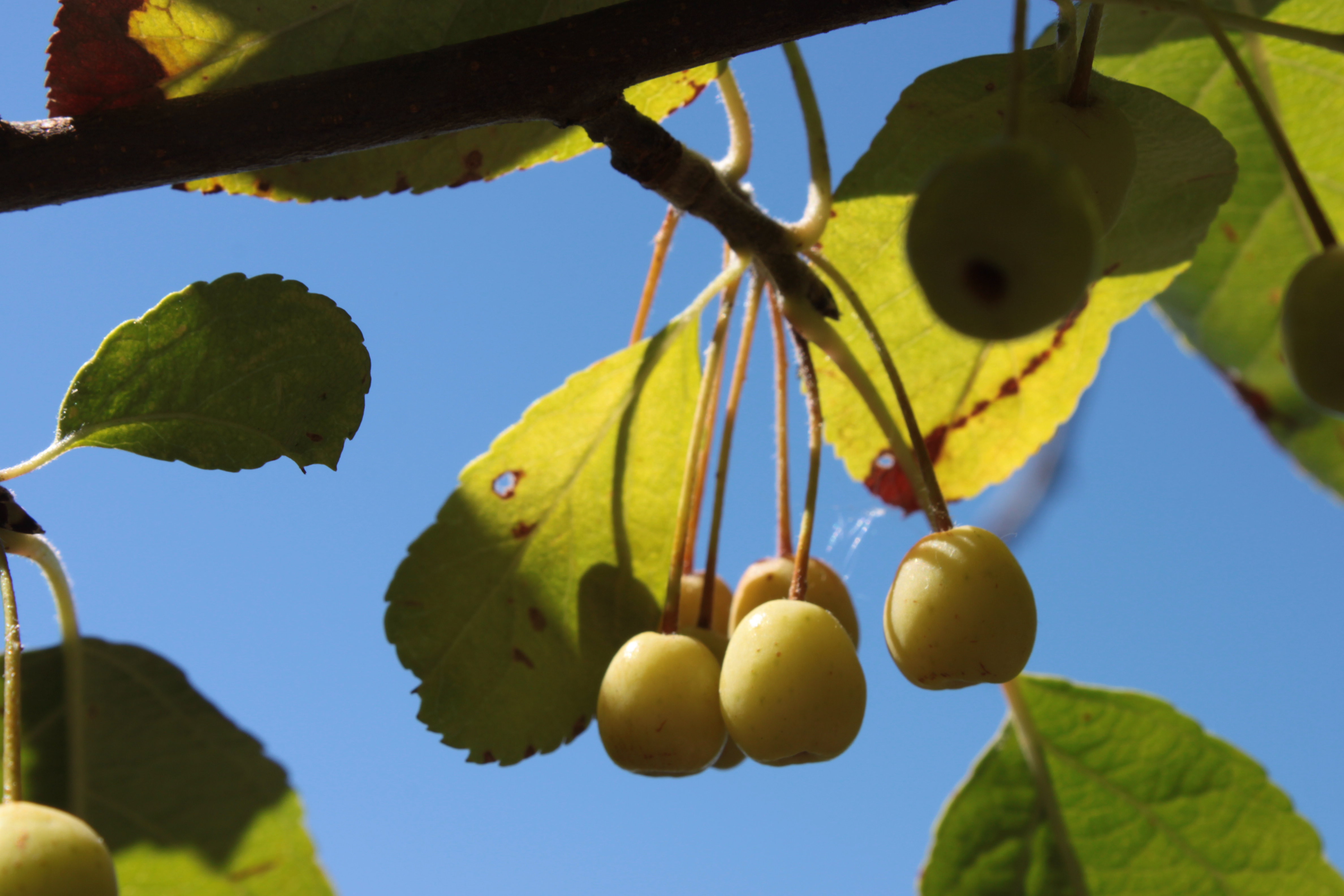







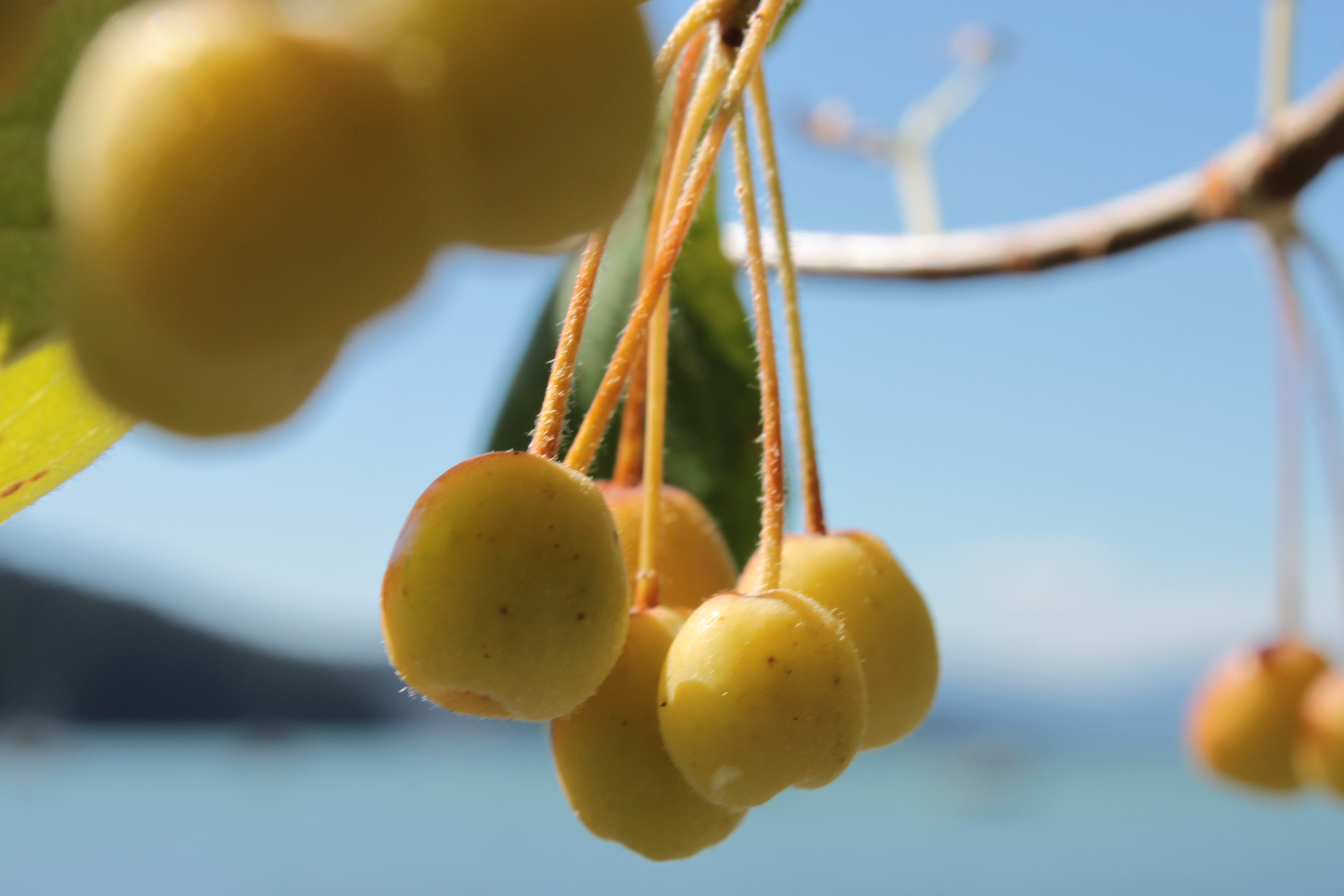

chokecherry, lhex̱wlhéx̱w / thuxwun (in the downriver dialect of Halkomelem), Prunus virginiana, Fulford Harbour, Salt Spring Island 2016 August 9 through 12, photographs by Alex Grünenfelder & Gordon Brent Brochu-Ingram


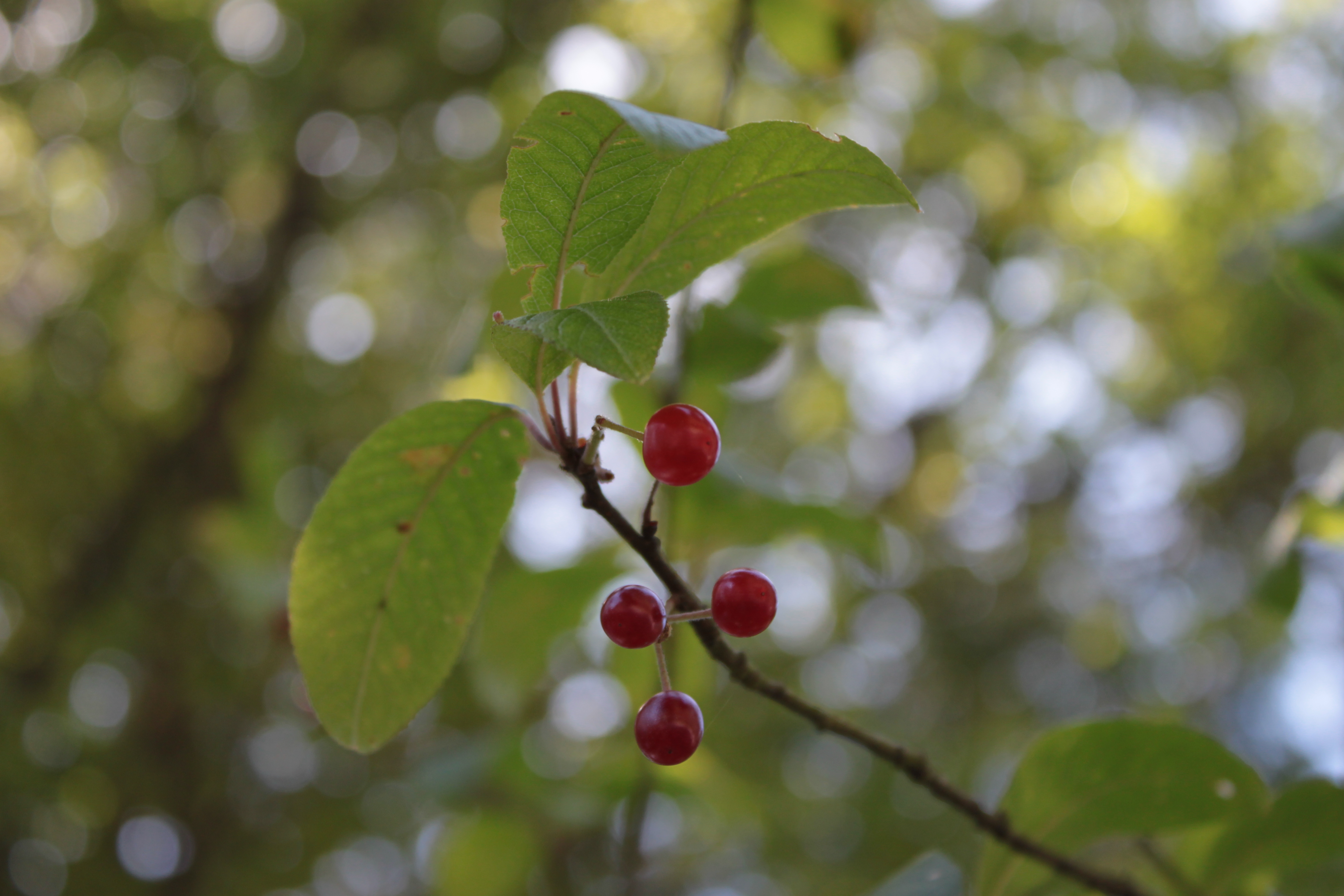


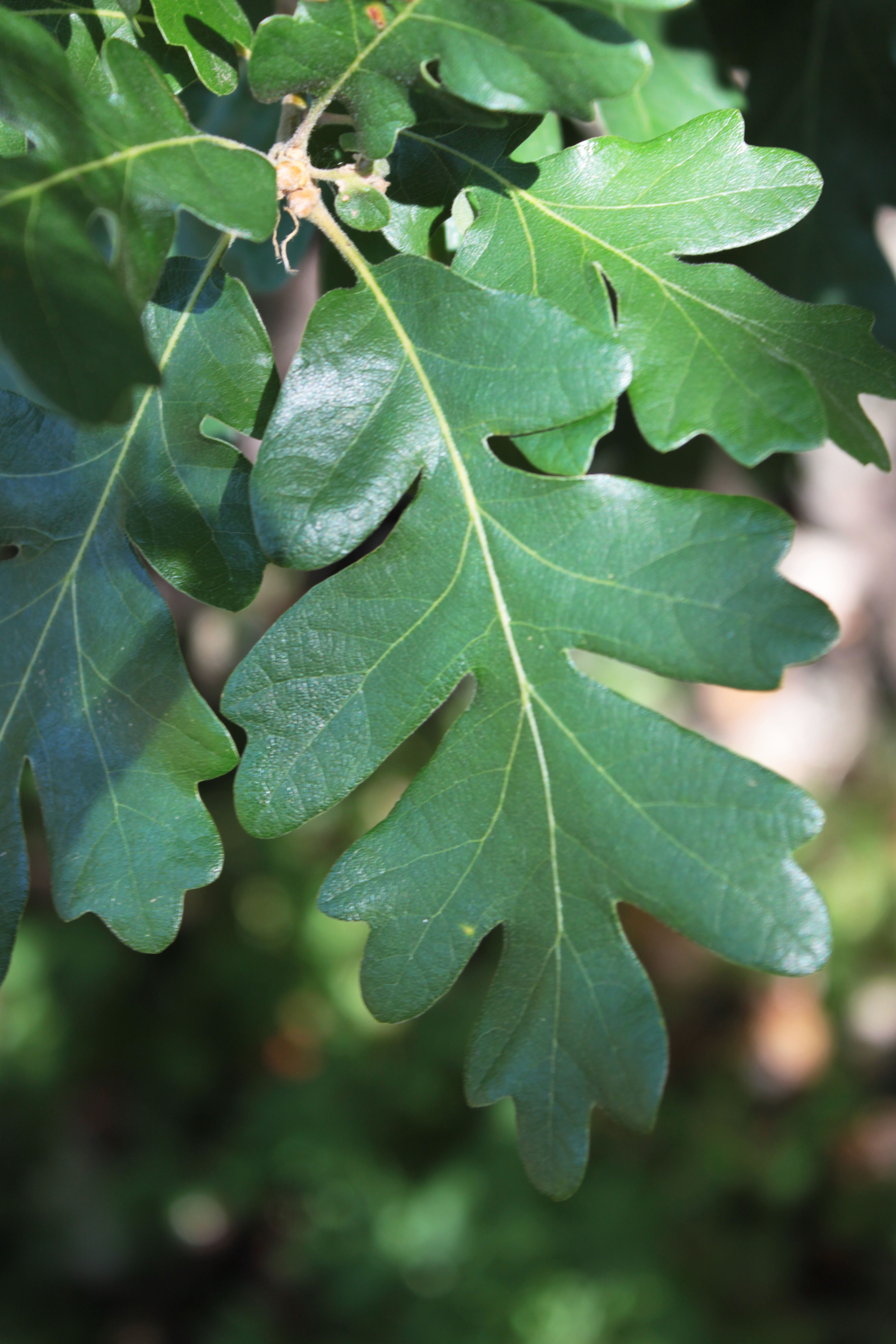
Garry oak, Quercus garryana, leaf on Burgoyne Bay, Salt Spring Island – This is an important tree species in drier parts of the West Coast, is sometimes a dominant in the Pacific Northwest, and ranges from south-western British Columbia to north-western Mexico. In some indigenous territories, including on Salt Spring Island, the acorns were gathered for food and processed in pits — with a suspected processing site roughly a kilometre and a half to the north of this site near the site of the Cowichan village of Xwaaqw’um at the south end of Burgoyne Bay.

ḴEXMIN is one of the traditional names, in SENĆOŦEN one of the score of Salish languages, for one of the most important regional medicinal & ceremonial herbs, with the Latin binomial of Lomatium nudicaule. There are similar words for this species in other Salish languages, and different though related spellings. ‘ḴEXMIN’ is thought to be an early word in the Salishan languages from which contemporary Salish language originated. The ‘ḴEX’, often spelled with with a ‘q’ in other languages, is thought to mean ‘hex’ as in negative forebodings. And the ‘ḴEX MIN‘ suggests a negation, removal, and cleansing of such current or future scourges. There is a broad renewal in engagement with ḴEXMIN as a symbol of renewal, healing, and intercultural conversations.

2008 May 25 Lomatium nudicaule on a roof garden above Vancouver Harbour

2008 May 30 Lomatium nudicaule, Vancouver

2008 May 30 Lomatium nudicaule with window & Vancouver Harbour

2004 June 21 Lomatium nudicaule forming seed at Belly-Rising-Up, at the south-east corner SȾÁUTW̱ (Tsawout) treaty lands, Central Saanich. The seeds in late June are green and powerful. The seeds mature and dry-out in August and are gathered for ceremonies and medicine.

Lomatium nudicaule flowers that become seeds

Lomatium species are native to the West of North America and mainly occur in drier, interior areas. The San Juan and Gulf Islands, of the Salish Sea and Puget Sound, are the only region where these plants occur as part of terrestrial-marine interface ecosystems. And the northern margins of Lomatium species are on the Gulf Islands.

2017 August 11 * Collecting ripe seeds ḴEXMIN (Lomatium nudicaule) at the beginning of ĆENŦÁWEN-COHO SALMON RETURN TO THE EARTH — in Beacon Hill Park, south-eastern Vancouver Island

The main office of KEXMIN field station is a kilometre north of the Salish village of W̱EN,NÁ,NEĆ that was a mixing place for speakers of two Salish languages: SENĆOŦEN and HUL’Q’UMI’NUM’. In the 1860s, the village included three lodges and a number of large wooden sculptures that were purchased and removed by the American Museum of Natural History in New York. We celebrate this place of confluence, fusion, and innovation.
